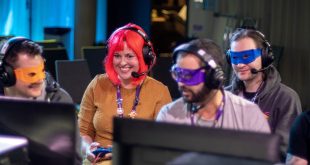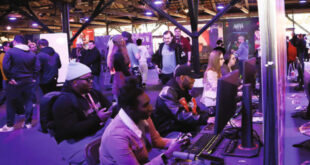
It’s certainly not every day that your small studio’s debut game is recognised with multiple BAFTA nominations. Even less so when you’re creating a game for a genre whose days in the sun have somewhat come to an end.
And yet that’s the position that the Cambridge-based Polygon Treehouse found themselves in this year. The studio, founded by a duo of veteran PlayStation developers, had already been nominated for Best Debut Game at the 2020 Game Awards, before finding out they were in the running for Best Debut Game and Best British Game at the 2021 BAFTAs.
It’s quite the achievement for an artistic, non-violent narrative experience (from two former Killzone developers). This is the story of Röki.
Perhaps surprisingly for a game born out of Cambridge, Röki is inspired by Scandinavian folklore. Its gorgeous storybook artstyle sees protagonist Tove trying to find her lost brother by interacting with everything from the terrifying water spirit Nokken, to the helpful and crafty creatures known as the Tomte.
“We had quite a few different ideas floating around,” says Polygon Treehouse co-founder Alex Kanaris-Sotiriou. “Then Tom [Jones, Polygon Treehouse co-founder] stumbled across Scandinavian folklore. It wasn’t really the plight of the gods, like Odin and Thor that interested us. It was more the folklore creatures, the creepy creatures from the lakes and the forests and the caves. They were so odd and beguiling, they really excited us.”
This led the pair to start thinking about a “greatest hits” of their own interpretation of these characters. We resisted calling it the “Scandanavian Avengers” in our chat with Kanaris-Sotiriou, but we reckon it’s definitely that, despite the absence of Thor.
THE MOOMINS ARE ABOUT TO CALL
Still, the folklore influence is front and centre. But what might come more of a surprise is the importance of everybody’s favourite polite trolls, the Moomins.
“There was an episode of the Moomins cartoon, where there’s this character called the Groke. It’s this unblinking character, who goes towards villages and freezes everything in its path, including people. But actually, all it wanted was a friend. There’s something really creepy in that, but it was really touching and quite tragic. We felt that there was something interesting there in that mix of emotions.”
That Moomins influence runs deeper than you might realise too. Tove and her brother Lars take their names from Moomins creator Tove Marika Jansson and her brother. We didn’t find any trolls in top hats in our playthrough, but we remain optimistic.
Putting the Moomins regretfully aside for a moment, that mix of emotions is certainly true of Röki. While the game is never explicit, remaining as family-friendly (though creepy) as the stories that inspired it, it doesn’t shy away from the tragedy behind many of its most terrifying beasts – such as the Nokken, a hugely threatening monster born from the spirit of a drowned girl.

POINT AND CLICK
Closer to home, Röki is an adventure game in the very classical sense. While efforts have been made to modernise the genre, the DNA of the point and click classics of the past run throughout Röki, with its puzzles often relying on creative uses and combinations of items in your suspiciously well-packed inventory.
The pair took inspiration from point-and-click classics such as Monkey Island, but were aware that they needed to take a more modern approach.
“In terms of modernising it,” says Kanaris-Sotiriou, “we gave the player direct control of the character in a 3D environment, which obviously you didn’t have in things like Grim Fandango. You can move around more freely, instead of having that disconnected cursor directing the character. You move, instead of sitting there telling a disconnected character to move.”
Another important change was in bringing quality of life improvements to the puzzle designs. While the point and click games of yesteryear are rightly loved, the puzzles themselves could be famously obtuse. It often felt as if the player was trying to work out what the developer was thinking, rather than putting a solution together with the facts made available to them.
“We did a huge amount of iteration on the puzzle design. Whilst we wanted the game to not pose zero challenge, because there’s very little satisfaction in that. But the game is also telling a story, and a story without an ending is not much of a good story. So a really big part was having the puzzle balanced in a way that most people will get to the end of the game, and see the conclusion of the story.
“We laid in these in-world hint systems, like the journal or the Tree of Many, who’s this oracle character who can give you some soft hints. We didn’t want to hand people too much, because some people will be able to work it out immediately and we shouldn’t get in the way of those people. But for the people who need some more assistance, we wanted to really give as much help as we could without shattering the fiction of you being in this world.
“You have to make sure that each step of the puzzle makes logical sense. That doesn’t mean you’re kind of restricted to it being boring or dull, but people need to be able to join the dots. As soon as you have people trying combinations and dragging everything down, it brings you out of the game’s story.
“So say, early in the game you combine a bear trap with a rope to make a grappling hook, to help a troll out. So we can try and lead you to that solution, and you can try things individually. And if you’re stuck, we’ll give you some of the in-world hints to try and get you there.”

ART FROM ADVERSITY
Alongside its puzzle design and memorable characters, perhaps one of Röki’s biggest strengths lies in its art style. The cinematic camera, mixed with the storybook art style, makes for a beautiful experience in certain areas. What comes as a surprise to us, then, that this art style was born out of a practical solution to a technical problem.
“We knew we wanted to make this epic adventure, which had lots of locations and different monsters. But our team is tiny – Tom and I were the only full time members. The team grew and shrank with sound designers, writers and composers, but we were the only ones full-time.
“We didn’t want to compromise on having this big epic story, probably foolishly. But in looking at the art style, we looked at the traditional 3D art pipeline that we knew, and well… We wanted to see what happens when we remove some big chunks. So we remove lighting, we remove texturing…. With Röki, what you have is a flat, shaded art style. That’s basically about pure colour choice and silhouettes, it really relies on those things. So, in removing those two things, it allows us to work much quicker and much freer. It allows us to create this epic fairytale world with just a tiny team.
“There’s lots of sleight of hand in the way it’s constructed. We have cinematic cameras, but we control them, it’s not a free camera. Part of that was accessibility, not everyone can do third-person camera control. It’s just assumed that everyone can do that. I was playing Life is Strange with my wife, and she played games growing up, but not ones with a third person camera controls. And that was really getting in the way of the story and her engaging with the game.
“So we took control of the cameras, which gave us a win on a number of fronts. First, we could construct the environments in a clever way. We didn’t have to see them from all angles, so we could save on polygons and lots of LOD stuff in the distance. But it also allowed us to then use the camera as a storytelling device. We have this holistic approach to storytelling… You know, video games are video games. It’s not just about the script. We wanted to use everything: animation, sound, audio and so on to reinforce the story that we’re trying to tell. So getting control of the camera back for that was a big win.
“From a practical problem solving point of view, we often work with creative limitations. Obviously, every team is different, but for us, working that way can actually throw up some really interesting things. Röki’s art style is something that we will be continuing to evolve moving forward, and has almost a signature of the game.”

NO-KILL ZONE
Röki has another Polygon Treehouse signature to look out for in the future. The game is a decidedly non-violent experience – which is maybe a surprise for a team with experience with the Killzone franchise.
“Ever since Killzone 2, we’ve been making first-person shooters. We learned a huge amount of craft on those games, with lots of talented people and we’re really grateful for that experience. We’ve taken a lot of those triple-A learnings into our indie work.
“But we’ve been working in those games for a while, and we’re getting older. You know, I think we’re a bit world weary, especially when you look at everything that’s going on in the world, which is even more pertinent recently. The idea of making a game that had an undercurrent of kindness running through it really resonated with us and where we’re at. We think that’s something for the studio moving forward, that we will carry on that route of non violent, emotional storytelling.”
While Kanaris-Sotiriou stresses that Polygon Treehouse isn’t going to exclusively develop adventure games, he is nonetheless keen to establish a brand for the new studio, one that the team will build around the success of Röki.
“I’m sure there’s got to be lots of elements of Röki that we will take into the next thing. It’ll be more of a departure genre wise, but there’s definitely the key elements of the polygon treehouse DNA that we want to continue. Things like the characters, the animation and the element of performance.
“We’re very pleased with the character work in the game, and we want to bring that to the fore even more. With how powerful things like the emotional storytelling that undercurrent of kindness has proven to be, I think we will be silly to not take that further.
“So it’s a really interesting challenge. How do you have a continuation of that DNA? It’s super early days still, but I think when people eventually see what it is we’re up to… I think it will feel quite different, but I think people will hopefully recognise it as a Polygon Treehouse game.”
They’d be silly indeed not to take what worked with Röki and run with it, given the nominations for The Game Awards and multiple BAFTAs. Something which obviously caught Polygon Treehouse by surprise.
“With the Game Awards, we had no idea whatsoever,” says Kanaris-Sotiriou. “I’d been trying to disengage from my phone, so I’d actually left my phone in the bedroom. Then my wife was complaining that my slippers were a right state, so I went to order some new ones and saw I had like a million notifications. So yeah, we that was a complete surprise when we found out.
“With the BAFTAs you have to put yourself forward, so obviously we knew we’d gone for it. But just being nominated for one would have been amazing – to be nominated for two was fantastic. It was slightly surreal being in the green rooms with all those people, and tiny Polygon Treehouse going, ‘hello!’ We were really, really touched by that. Obviously we didn’t win any of them, but we’re still grinning from ear to ear about it. It’s a massive win for us.”
All things considered, it’s a promising start for such a small studio. Though Kanaris-Sotiriou is careful to nip that ‘two man team’ chat in the bud. They may have been the only full-time members, but he’s enormously grateful to everyone who came on board to make Röki possible.
“Thanks so much to the team, we had a really awesome team of people we collaborated with. We definitely couldn’t have made the game without them. Thanks to all their passion in making the game. Thanks to the players as well! We’re excited to, when we’re ready, show people what we’re up to next.”

 MCV/DEVELOP News, events, research and jobs from the games industry
MCV/DEVELOP News, events, research and jobs from the games industry




